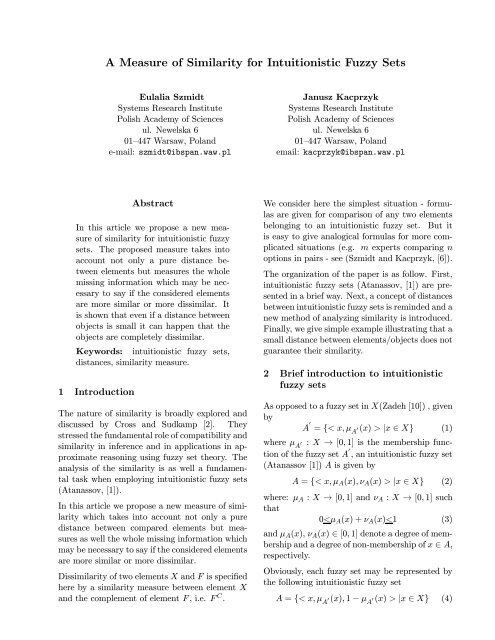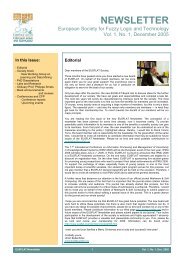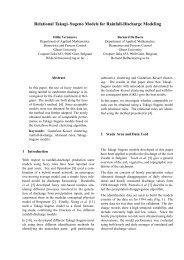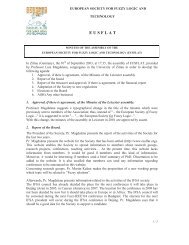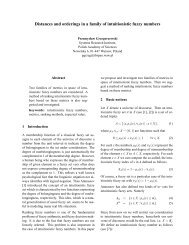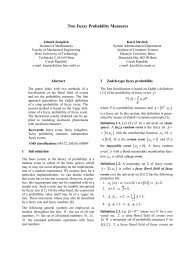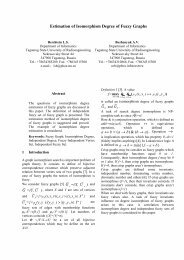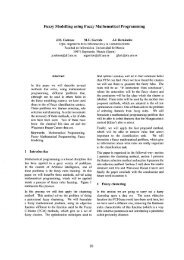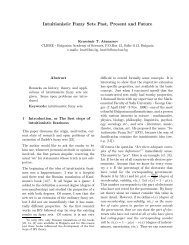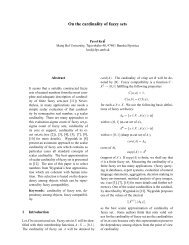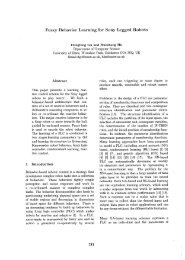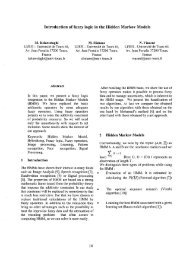A Measure of Similarity for Intuitionistic Fuzzy Sets - ResearchGate
A Measure of Similarity for Intuitionistic Fuzzy Sets - ResearchGate
A Measure of Similarity for Intuitionistic Fuzzy Sets - ResearchGate
Create successful ePaper yourself
Turn your PDF publications into a flip-book with our unique Google optimized e-Paper software.
A <strong>Measure</strong> <strong>of</strong> <strong>Similarity</strong> <strong>for</strong> <strong>Intuitionistic</strong> <strong>Fuzzy</strong> <strong>Sets</strong><br />
Eulalia Szmidt<br />
Systems Research Institute<br />
Polish Academy <strong>of</strong> Sciences<br />
ul. Newelska 6<br />
01—447 Warsaw, Poland<br />
e-mail: szmidt@ibspan.waw.pl<br />
Abstract<br />
In this article we propose a new measure<br />
<strong>of</strong> similarity <strong>for</strong> intuitionistic fuzzy<br />
sets. The proposed measure takes into<br />
account not only a pure distance between<br />
elements but measures the whole<br />
missing in<strong>for</strong>mation which may be necessary<br />
to say if the considered elements<br />
are more similar or more dissimilar. It<br />
is shown that even if a distance between<br />
objects is small it can happen that the<br />
objects are completely dissimilar.<br />
Keywords: intuitionistic fuzzy sets,<br />
distances, similarity measure.<br />
1 Introduction<br />
The nature <strong>of</strong> similarity is broadly explored and<br />
discussed by Cross and Sudkamp [2]. They<br />
stressed the fundamental role <strong>of</strong> compatibility and<br />
similarity in inference and in applications in approximate<br />
reasoning using fuzzy set theory. The<br />
analysis <strong>of</strong> the similarity is as well a fundamental<br />
task when employing intuitionistic fuzzy sets<br />
(Atanassov, [1]).<br />
In this article we propose a new measure <strong>of</strong> similarity<br />
which takes into account not only a pure<br />
distance between compared elements but measures<br />
as well the whole missing in<strong>for</strong>mation which<br />
may be necessary to say if the considered elements<br />
are more similar or more dissimilar.<br />
Dissimilarity <strong>of</strong> two elements X and F is specified<br />
here by a similarity measure between element X<br />
and the complement <strong>of</strong> element F ,i.e.F C .<br />
Janusz Kacprzyk<br />
Systems Research Institute<br />
Polish Academy <strong>of</strong> Sciences<br />
ul. Newelska 6<br />
01—447 Warsaw, Poland<br />
email: kacprzyk@ibspan.waw.pl<br />
We consider here the simplest situation - <strong>for</strong>mulas<br />
are given <strong>for</strong> comparison <strong>of</strong> any two elements<br />
belonging to an intuitionistic fuzzy set. But it<br />
is easy to give analogical <strong>for</strong>mulas <strong>for</strong> more complicated<br />
situations (e.g. m experts comparing n<br />
options in pairs - see (Szmidt and Kacprzyk, [6]).<br />
The organization <strong>of</strong> the paper is as follow. First,<br />
intuitionistic fuzzy sets (Atanassov, [1]) are presented<br />
in a brief way. Next, a concept <strong>of</strong> distances<br />
between intuitionistic fuzzy sets is reminded and a<br />
new method <strong>of</strong> analyzing similarity is introduced.<br />
Finally, we give simple example illustrating that a<br />
small distance between elements/objects does not<br />
guarantee their similarity.<br />
2 Brief introduction to intuitionistic<br />
fuzzy sets<br />
As opposed to a fuzzy set in X(Zadeh [10]) , given<br />
by<br />
A <br />
= {< x,µ <br />
A (x) > |x ∈ X} (1)<br />
where µ <br />
A : X → [0, 1] is the membership function<br />
<strong>of</strong> the fuzzy set A <br />
, an intuitionistic fuzzy set<br />
(Atanassov [1]) A is given by<br />
A = {< x,µA(x),νA(x) > |x ∈ X} (2)<br />
where: µA : X → [0, 1] and νA : X → [0, 1] such<br />
that<br />
0
For each intuitionistic fuzzy set in X, wewillcall<br />
πA(x) =1− µA(x) − νA(x) (5)<br />
a hesitation margin (or an intuitionistic fuzzy index)<br />
<strong>of</strong>x∈ A and, it expresses lack <strong>of</strong> knowledge<br />
<strong>of</strong> whether x belongs to A or not (cf. Atanassov<br />
[1]). It is obvious that 0
a<br />
F<br />
D(<br />
0,<br />
0 , 1)<br />
X<br />
c<br />
F<br />
A ( 1,<br />
0 , 0)<br />
G<br />
B(<br />
0,<br />
1,<br />
0)<br />
Figure 1: The triangle ABD explaining a ratiobased<br />
measure <strong>of</strong> similarity<br />
(µ, ν, π) <strong>of</strong> any element belonging to an intuitionistic<br />
fuzzy set can be represented as the coordinates<br />
<strong>of</strong> the point (µ, ν, π) belonging to the triangle<br />
ABD (Figure 1). Point A represents elements<br />
fully belonging to an intuitionistic fuzzy<br />
set (µ =1),pointB represents elements fully not<br />
belonging to an intuitionistic fuzzy set (ν =1),<br />
point D represents elements with hesitation margin<br />
π = 1 i.e, about which we are not able to say<br />
if they belong or not belong to an intuitionistic<br />
fuzzy set. Any other combination <strong>of</strong> the parameters<br />
characteristic <strong>for</strong> elements belonging to an<br />
intuitionistic fuzzy set can be represented inside<br />
triangle ABD.<br />
In the simplest situations we assess similarity <strong>of</strong><br />
any two elements X and F belongingtoanintuitionistic<br />
fuzzy set (or sets). The proposed measure<br />
says if X is more similar to F or to F C ,<br />
where F C is a complement <strong>of</strong> F .Inotherwords,<br />
the proposed measure says if X is more similar or<br />
more dissimilar to F .<br />
Definition 1<br />
⎧<br />
1<br />
⎪⎨<br />
1 −<br />
Sim(X, F) =<br />
⎪⎩<br />
<strong>for</strong> a =0, 0
F =(0.4, 0.5, 0.1)<br />
so<br />
F C =(0.5, 0.4, 0.1)<br />
and from (10) we have<br />
lIFS(X, F) = 1<br />
(|0.5 − 0.4| + |0.4 − 0.5| +<br />
2<br />
+ |0.1 − 0.1|) =0.1 (11)<br />
what means that the distance is small - basing on<br />
it only we would say that X and F are similar.<br />
However<br />
lIFS(X, F C ) = 1<br />
(|0.5 − 0.5| + |0.4 − 0.4| +<br />
2<br />
+ |0.1 − 0.1|) = 0 (12)<br />
what means that X is just the same as F C .We<br />
can not speak at all about similarity <strong>of</strong> X and F<br />
despite that the distance between them is small.<br />
Summing up:<br />
• When a distance between two (or more) objects,<br />
sets is big it means <strong>for</strong> sure that the<br />
similarity does not exist.<br />
• Whenadistanceissmall,wecansaynothing<br />
sure about similarity basing on a pure<br />
distance between two objects only (when not<br />
taking into account complements <strong>of</strong> the objects<br />
as in (10)). The distance between objects<br />
can be small and the compared objects<br />
can be more dissimilar than similar.<br />
4 Concluding remarks<br />
We proposed a new measure <strong>of</strong> similarity. It was<br />
shown that in some situations, pure distance is<br />
not a proper measure <strong>of</strong> similarity.<br />
<strong>Intuitionistic</strong> fuzzy sets with their possibilities <strong>of</strong><br />
taking into account non-memberships are the tool<br />
which makes it possible to notice the fact that a<br />
small distance between the compared objects does<br />
not mean that the objects are similar.<br />
References<br />
[1] Atanassov K. (1999), <strong>Intuitionistic</strong> <strong>Fuzzy</strong><br />
<strong>Sets</strong>: Theory and Applications. Springer-<br />
Verlag.<br />
[2] Cross V. and Sudkamp T. (2002) <strong>Similarity</strong><br />
and Compatibility in <strong>Fuzzy</strong> Set Theory.<br />
Physica-Verlag.<br />
[3] Szmidt E. (2000): Applications <strong>of</strong> <strong>Intuitionistic</strong><br />
<strong>Fuzzy</strong> <strong>Sets</strong> in Decision Making. (D.Sc.<br />
dissertation) Techn. Univ., S<strong>of</strong>ia, 2000.<br />
[4] Szmidt E. and Kacprzyk J. (2000) Distances<br />
between intuitionistic fuzzy sets, <strong>Fuzzy</strong> <strong>Sets</strong><br />
and Systems, Vol.114, No.3, pp.505 — 518.<br />
[5] Szmidt E., Kacprzyk J. (2001) Entropy <strong>for</strong><br />
intuitionistic fuzzy sets. <strong>Fuzzy</strong> <strong>Sets</strong> and Systems,<br />
vol. 118, No. 3, pp. 467—477.<br />
[6] Szmidt E. and Kacprzyk J. (2002) Analysis<br />
<strong>of</strong> Agreement in a Group <strong>of</strong> Experts via Distances<br />
Between <strong>Intuitionistic</strong> <strong>Fuzzy</strong> Preferences.<br />
Proc. 9th Int. Conf. IPMU 2002, Annecy,<br />
France, July 1—5, pp. 1859—1865.<br />
[7] Szmidt E. and Kacprzyk J.(2002b) An <strong>Intuitionistic</strong><br />
<strong>Fuzzy</strong> Set Based Approach to Intelligent<br />
Data Analysis (an application to medical<br />
diagnosis). In A. Abraham, L. Jain, J.<br />
Kacprzyk (Eds.): Recent Advances in Intelligent<br />
Paradigms and Applications. Springer-<br />
Verlag, pp. 57-70.<br />
[8] Szmidt E. and Kacprzyk J. (2002c) Evaluation<br />
<strong>of</strong> Agreement in a Group <strong>of</strong> Experts via<br />
Distances Between <strong>Intuitionistic</strong> <strong>Fuzzy</strong> <strong>Sets</strong>.<br />
Proc. IS’2002 - Int. IEEE Symposium: Intelligent<br />
Systems, Varna, Bulgaria, IEEECatalog<br />
Number 02EX499, pp. 166-170.<br />
[9] Tversky A. (1977) Features <strong>of</strong> similarity. Psychol.<br />
Rev. Vol. 84, pp. 327—352.<br />
[10] L.A. Zadeh (1965) <strong>Fuzzy</strong> sets. In<strong>for</strong>mation<br />
and Control, 8, 338—353.


